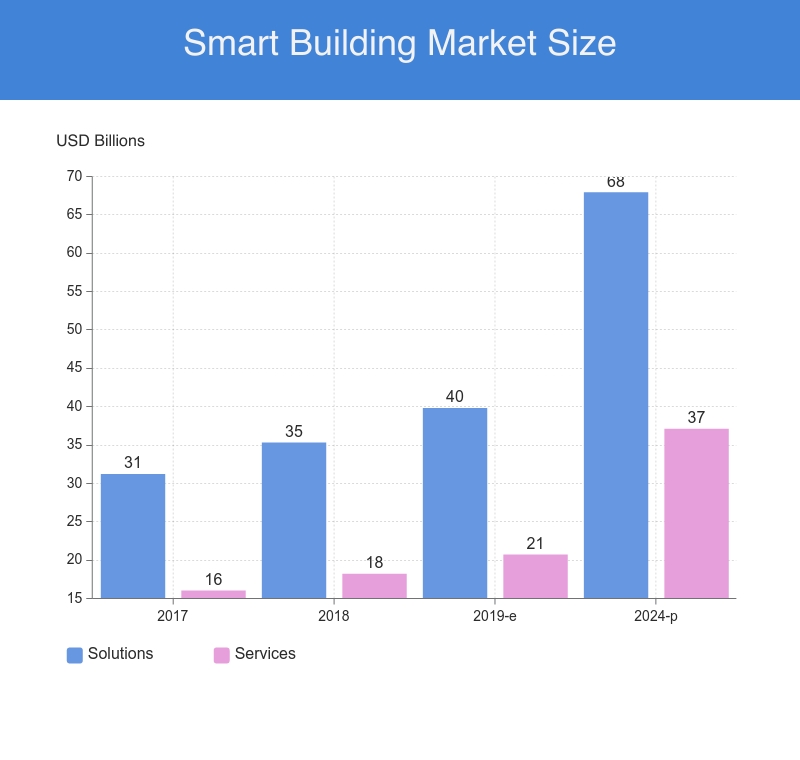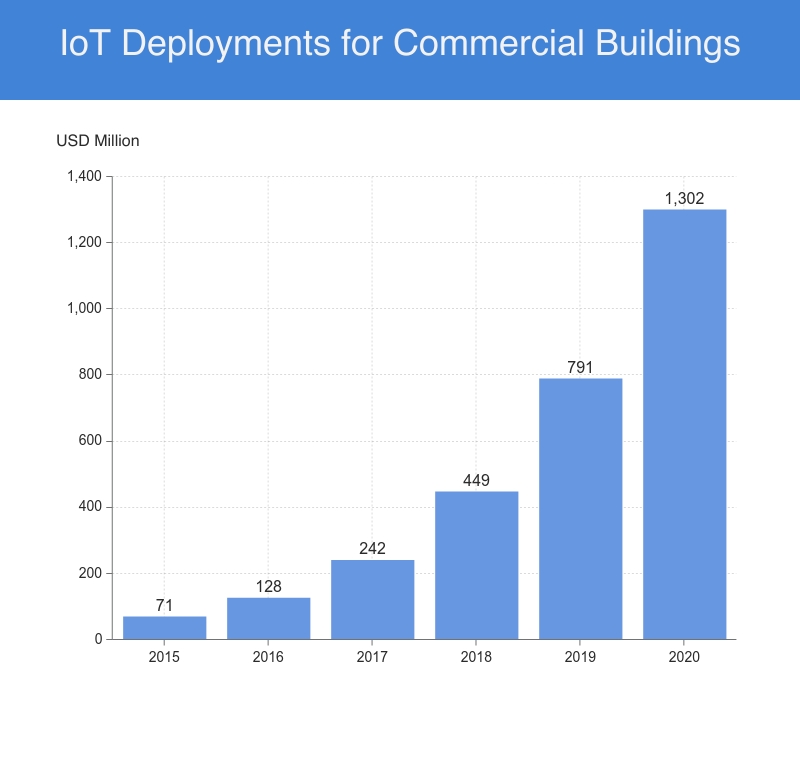
The growth of the Smart Building market has far surpassed the industry forecasts and expectations. Businesses today are actively incorporating the Internet of Things (IoT) into their buildings to enable connectivity, building usage optimization, and energy saving. In fact, 58% of the organizations all over the world have plans to invest in Smart Building technology, for their potential in making infrastructures efficient, effective, and less expensive.
In this blog, we have rounded up the reasons why Smart Building solutions are developing faster and how it helps businesses. Before we delve into the blog, here is a quick introduction to Smart Buildings.
Smart Building: What it means
Smart Buildings are facilities that use automation to control lighting, HVAC, security and other systems of the buildings. The hardware of the building, typically, are integrated through IoT and are made to share information with each other to operate independently.
Smart Building solutions significantly improve the life of the hardware with optimized usage, generate data for informed decision making, reduce energy consumption, and make the building eco-friendly. An American Council for an Energy-Efficient Economy (ACEEE) report suggests that offices can achieve an average energy savings of 18%, retail stores and hospitals can achieve 14%, and hotels average at 8% energy savings utilizing smart building technology.
Rising Smart Building trends
More than the advent of technology and innovation, the demand for efficiency, planning, and cost-saving potential is pushing the growth of Smart Building solutions. In 2019, the Smart Building market was valued at USD 60.7 billion; by 2024, it is estimated to reach USD 105.8 billion at a CAGR of 11.7%.
The two segments of the Smart Building market, solutions and services, hold USD 39.9 billion and USD 20.8 billion respectively. The Smart Building solution segment—creating solutions to manage building operations—is forecasted to grow at 11.5% CAGR and reach USD 68.6 billion by 2024, and the Smart Building services segment—consulting, integration, maintenance, and support—is forecasted to grow at 12.3% CAGR and reach USD 37.2 billion by 2024.

Why Smart Buildings are the future
Businesses are realizing the importance of advanced cybersecurity, data analytics, and hardware integration that can bolster security, building optimization, and ultimately cut costs. 30% of the overall energy generated is either wasted or not used productively, according to the US Department of Energy. This is a considerable financial loss every business should avoid, and Smart Buildings can make that happen. Here are the key factors pioneering the rise of Smart Buildings.
1. Rapid adoption of IoT
IoT technology makes it possible for the systems in a building to interact with each other and perform their duties without any manual intervention. With the help of sensors, IoT-enabled Building Management Systems (BMS) collect information about how people interact with the building and help optimize building usage for efficiency.
For instance, in a smart workplace building, the BMS continuously collects the information of which corridors are most taken, which rooms are occupied at the given time, which devices are often used, and more. Lighting and HVAC of the infrastructure are automatically adjusted with respect to the weather to ensure comfortable and productive working hours. Automatic lighting controls based on occupancy further helps to conserve energy and improve the business bottom line.
Connectivity is what makes the idea of Smart Buildings a reality. And with every year, since the inception of the internet, the speed, stability, and security have improved incredibly, making IoT highly effective. The 5G technology can further enhance the responsiveness of the devices to the point of almost instantaneous, improving smart building automation efficiency and occupant experience.
From a mere USD 71 million in 2015, IoT deployments for commercial real estate across the world has grown to USD 1.3 billion in just five years.

2. Increasing space and asset optimization potential
Many businesses have been overlooking space utilization for quite some years and it resulted in investing in space that was never needed. In addition, it also costs energy and maintenance. IoT and cognitive computing can track space usage and provide a simulation of how devices and spaces are used over time.
For instance, the distribution of conference room usage, asset usage, and even desk-level occupancy can be learned and optimized for effective usage. Space usage frequency, availability, and energy consumption information can help regulate efficient usage strategies without losing employees’ comfort.
3. Growing need for efficiency and sustainability
People are aware of the effects of climate change more now than ever. Quite a few effects such as melting polar ice caps, declining water supplies, and increases heat are already evident enough for countries to take a unified approach.
IoT-powered Smart Buildings, with their efficient management of water and energy, help to reduce businesses’ carbon footprint. Predictive maintenance and better use of resources further complement Smart Buildings’ energy savings. It should also be noted that according to the United Nations Environment Program, buildings are responsible for 36% of annual energy-related CO2 emissions.
The rise of regulations and standards such as Building Industry Consulting Service International (BICSI) and Leadership in Energy and Environmental Design (LEED) further promote the incorporation of technologies to optimize buildings. The recent BICSI 007 standard’s incorporation of automation, smart lighting, remote powering systems, and structured cabling are some of the fundamentals of Smart Buildings.
Smart Buildings: The Future of Buildings
Despite the potential of IoT and Smart Buildings, the lack of skilled professionals has been hindering the growth of the technology. The skill difference between managing a limited number of systems on the premises and a large number of interconnected machines is huge. The emphasis on quality integration and following security protocols requires further increases the skill gap.
Partnering with Enlighted, mySupplier delivers highly reliable Smart Building solutions for businesses to reduce expenses, save energy, optimize space and asset usage, and make informed infrastructure-based business decisions.
Enlighted is an IoT solutions company providing leading technology-powered platforms to make buildings smart and sustainable. mySupplier, in collaboration with Enlighted, brings you IoT solutions that include technology for digital contact tracing to mitigate the risks of a COVID outbreak and help your business operate safely.


